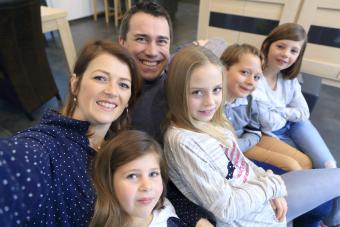
Blended families, also called stepfamilies or remarriage families, are one of many modern family types in the world. Discover research-based information and statistics about the various aspects of blended families.
General Blended Family Statistics
The U.S. government does not specifically collect data on stepfamilies. Some organizations and groups attempt to collect data, but their methods are often limited. While these statistics provide some insight into the intricate nature of blended families, they may not accurately describe all stepfamilies.
Prevalence of Blended Families
While there aren't a lot of specific statistics on stepfamilies, Pew Research Center reports a generalized look at blended families in the U.S. today. For the purpose of better understanding the blended family structure, a blended family is defined as any household that includes a stepparent, step-sibling, or half-sibling.
- Sixteen percent of children live in blended families.
- Per the U.S. Bureau of Census, 1300 new stepfamilies are formed each day.
- 40% of families in the U.S. are blended with at least one partner having a child from a previous relationship before marriage.
- The number of kids living in blended families has been stable for nearly thirty years.
- Children of Hispanic, Black, and white backgrounds are equally likely to live in this type of family.
- Children from Asian families are half as likely as Hispanic, Black, or white kids to be part of a blended family.
- Six in ten women's remarriages create blended families.
Statistics on Stepfamily Success
Every family is unique, and so is its success rate. However, stepfamily studies suggest about 60 to 70 percent of marriages involving children from a previous marriage fail, a statistic reiterated by the Census Bureau, which found that divorce increases in relation to the number of times one marries. This is about twice the percentage of overall marriages ending in divorce, which sits around 30-35 percent.
Part of what helps some stepfamilies be more successful rests on the children's perceived bonds with both parents inside the home. Adolescents who believe they have strong bonds with both their own mother and their stepfather in this type of family feel a greater sense of family belonging than kids who don't view both of these household relationships in a positive light.
Recent research from the UK found that kids from stable homes with different types of family structures were equally successful academically because of their family stability, not their family type. Thus, establishing a positive environment is more important than family type. What can make blended families work is having two cooperative parents, who create a stable, loving environment for their children.
Perceptions About Blended Families
In the past, divorce was frowned upon, and so were those who chose it. Some say this stigma sticks with remarried parents still today as one of the pervasive blended family problems. However, in a recent blended family research paper, about three-quarters of college students claim there is no shame in being from a stepfamily and believe millennials view these families differently than older generations. Perceptions regarding non-traditional families continue to move forward in a positive and progressive manner.
Effects of Blended Families on Children
The formation of a blended family can have different effects on kids of all ages. Some may find the transition easy, while others may struggle to find their place in the new family structure.

Statistics on Mental Health and Family Structure
Yes, members of blended families can deal with mental health issues, but so do members of all families. Research on family structure from Australia highlights the notion that children in one-parent, blended, and stepfamilies may experience a higher prevalence of mental disorders than those in the traditional two-biological parent families. Some of the disorders that members of blended families face include separation anxiety disorder, major depressive disorder, and conduct disorder.
However, research on the effects of family structure on children's hospitalizations for mental health concerns shows roughly equal numbers of admissions for kids from biologically intact and blended families. Furthermore, a study on the effects of family structure on depressive symptoms in adolescents from military families showed no differences between different family types - as long as the youth felt connected and supported. Again, this research points to family connectivity and support being the primary catalyst to children's well-being.
It appears that strong family relationships can act as a buffer for some of the stressors that may cause more extreme emotional reactions. Kids who report closeness with their biological parent and stepparent at home tend to feel less stress during the family transition to stepfamily life.
Statistics on Academics & Adult Life With Regard to Family Structure
When comparing academic achievement as it relates to family structures, kids living in first-marriage nuclear families tend to do better than kids in nontraditional families. However, these differences are usually small, and about 80 percent of stepchildren function well on developmental outcomes, including academic success.
The study revealed that children raised in stepfamilies were more apt to leave home earlier than those raised in nuclear families, and establish families of their own. They also were found more likely to enter romantic relationships before children raised in nuclear families, and tend to identify themselves as adults earlier on.
Global Stepfamily Statistics
A look at global statistics provides more insight into the prevalence of blended families throughout the world.
- According to the most recent census data from the UK, there were about 544,000 stepfamilies with children in England and Wales in 2011.
- Approximately 5% of kids in Australia in 2011 were living with a biological parent and step-parent based on the most recent statistics about modern families in Australia.
- About 518,000 families in Canada were stepfamilies with children according to the most recent data from 2016.
- The most recent data from France shows that in 2011 there were about 720,000 blended families in Metropolitan France, which equates to one in ten children.
Every Blended Family Is Unique
Because blended families appear to still be in the minority, little is definitive about their intricacies and impacts. Although data and research are helpful in understanding some of the aspects of stepfamilies, it's important to remember that each person and family is a unique entity.







